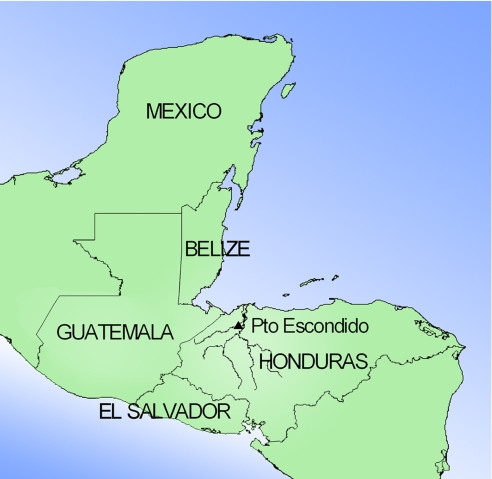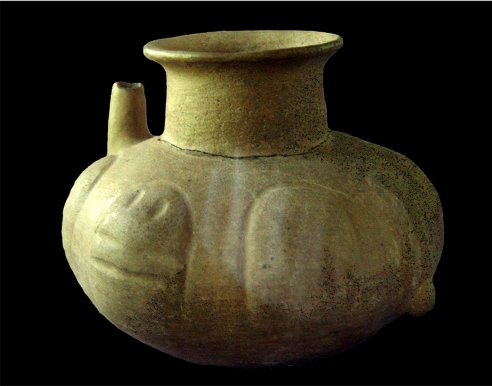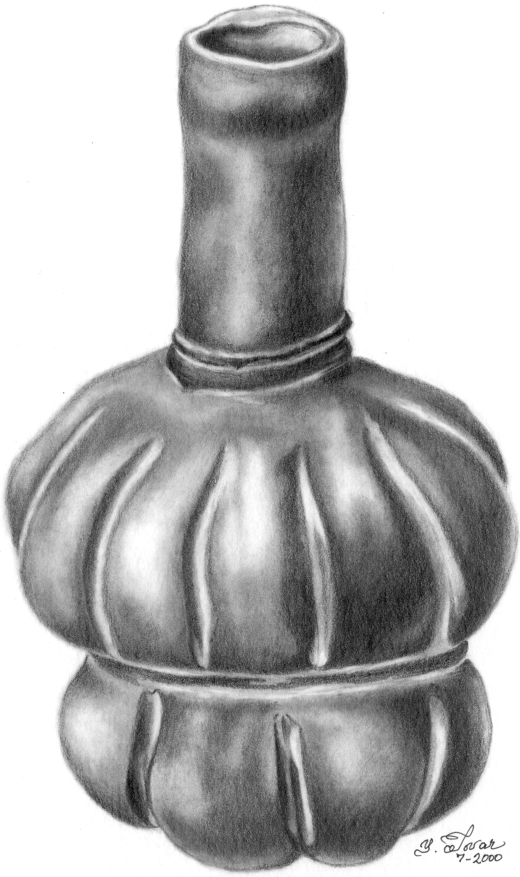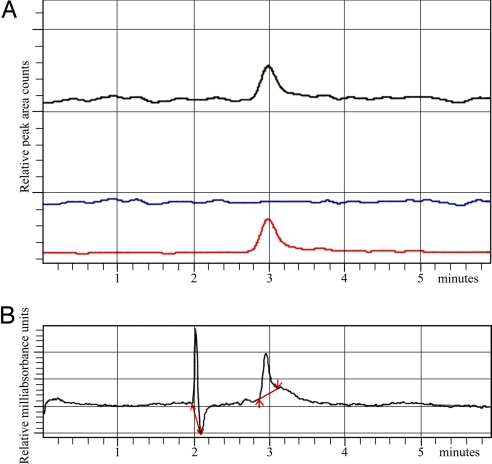Abstract
Chemical analyses of residues extracted from pottery vessels from Puerto Escondido in what is now Honduras show that cacao beverages were being made there before 1000 B.C., extending the confirmed use of cacao back at least 500 years. The famous chocolate beverage served on special occasions in later times in Mesoamerica, especially by elites, was made from cacao seeds. The earliest cacao beverages consumed at Puerto Escondido were likely produced by fermenting the sweet pulp surrounding the seeds.
Keywords: archaeology, chemistry, Honduras, Mesoamerica
Beverages produced from Theobroma spp. were integral to virtually all social and ritual occasions among the Aztecs and their contemporaries, and cacao was in consequence one of the most valued commodities in 16th-century Mesoamerica (1, 2). The distinctive Mesoamerican style of cacao preparation involved fermenting cacao seeds (or “beans”), drying them, optionally toasting them, grinding them, and mixing them with water in a thick bitter suspension. Invading Europeans came to appreciate this beverage (chocolatl in the language of the Aztecs), giving rise to the modern chocolate industry.
All wild relatives of domesticated Theobroma are native to northern Amazonian South America, although cacao was not cultivated there in precolumbian times, and the only known native South American uses either employ the fruity pulp surrounding the seeds as a refreshing source of liquid or ferment it to produce chicha (an alcoholic beverage often made from maize or manioc). Whether cacao arrived in Mesoamerica through human agency or whether the natural range of Theobroma once extended through Central America is a controversial issue (3, 4). Cultivation, domestication, and chocolate processing were Mesoamerican innovations, and fermented cacao chichas were also produced there. Cacao use in Mesoamerica can be tracked back into precolumbian times through depictions, texts, and residues of actual beverages (2, 5–8).
Chemical analysis of residues extracted from pottery vessels from the lower Ulúa Valley in northern Honduras demonstrates that cacao beverages were consumed there at least as early as 1100 B.C., some 500 years earlier than previously documented (7, 8). The chemical evidence does not distinguish between a beverage made from the cacao seeds and chicha made from the pulp, but we argue, on the basis of changes in serving vessels, that the distinctive Mesoamerican chocolate drink was a byproduct of earlier fermented drinks. The fact that natural products high in sugar were used to produce alcoholic beverages in many parts of the world at an early date, including Neolithic China (9) and the Near East (10–12), is consistent with our findings.
The Ulúa Valley was particularly famous for its production of high-quality cacao in the 16th century (13). Precolumbian texts and depictions document the importance of cacao during the millennium preceding the Spanish invasion. The earlier history of cacao, before it appeared in preserved depictions, must be reconstructed from other kinds of material remains. The process of cacao preparation destroys the pods and seeds, making recovery of macrobotanical remains rare. Theobromine, a chemical component limited in Central America to Theobroma spp, has been identified elsewhere in visible residues preserved inside intact pottery vessels of the Classic (mid-1st millennium A.D.) and Middle Formative periods (mid-1st millennium B.C.) (5–8).
Results
Puerto Escondido is a small but wealthy village in the lower Río Ulúa Valley (Fig. 1), where excavation of deeply stratified deposits, buried under several meters of later occupation debris, has revealed indications of domestic activity beginning before 1500 B.C., near the beginnings of settled village life in Mesoamerica, and extending through the 1st millennium A.D. (14). Thirteen pottery sherds, from early levels in two widely separated excavation areas in different groups of buildings, were selected for chemical analysis. Each sherd was associated with a specific deposit in a sequence of alternating fills and ancient living surfaces/floors. The selection of sherds sampled several vessel forms that we expected were most likely to have been used in serving and drinking cacao beverages; these expectations are based on functionality of shapes and degree of added decoration that might mark vessels as suitable for special occasions. Eleven of the sherds tested positive for theobromine and/or caffeine (Table 1).
Fig. 1.
Eastern Mesoamerica
Table 1.
Sherds from Puerto Escondido testing positive for theobromine
| Excavation context | Vessel form | Vessel-surface treatment | Type name |
|---|---|---|---|
| Playa phase (900–200 B.C.) | |||
| 8K-31 | Bottle spout | Brown, glossy | Bodega Brown |
| Chotepe phase (1100–900 B.C.) | |||
| 4DL-107 | Open bowl with flaring walls | Black, glossy | Boliche Black |
| 4DC-104* | Base of cylinder | Black, glossy | Boliche Black |
| 4DC-116 | Open bowl with flaring walls | Light brown, glossy, with fugitive red paint | Bonilla Yellow–Brown |
| 4DC-118 | Jar | Brown, with pattern burnishing | Urbe Unslipped (pattern burnished variety) |
| 4DC-118 | Open bowl with flaring walls | Black, glossy | Boliche Black |
| 4DC-23* | Open bowl with flaring walls | Light brown, glossy | Bonilla Yellow–Brown |
| 4DM-17* | Open bowl with flaring walls | Gray, glossy | Fía Metallic Gray |
| 4DC-130 | Open bowl with flaring walls | Gray, glossy | Fía Metallic Gray |
| 4DC-130 | Open bowl with flaring walls | Black, glossy | Boliche Black |
| Ocotillo phase (1400–1100 B.C.) | |||
| 4DK-136 | Bottle spout | Brown, glossy | Barraca Brown |
The first digit of the sample code indicates the sector of the site from which the sherd was recovered.
*Borderline-positive samples.
The most recent positive sample (8K-31), from a spouted bottle in the famous Playa de los Muertos style (Fig. 2), confirms the earliest previous evidence of cacao use in the Middle Formative period (7, 8). A radiocarbon sample from the same excavation context has an intercept at 380 calibrated years (cal) B.C.; bracketing samples from immediately earlier and later stratigraphic contexts have intercepts at 370 cal B.C. and 360/290/230 cal B.C.
Fig. 2.
Bodega Brown bottle from northern Honduras. This vessel is of the same type and form as sample 8K-31. The bottle is from the collection of the Instituto Hondureño de Antropología e Historia, Museo de San Pedro Sula, Honduras.
The 10 earlier samples–sherds from small, carefully decorated bowls, jars, and bottles from deposits dating to the earlier part of the Early Formative period–extend the history of cacao use at least 500 years farther into the past. The Chotepe phase (ca. 1100–900 B.C.) samples were excavated in contexts that yielded artifacts associated with a pan-Mesoamerican interaction sphere. Samples from contexts 4DL-107, 4DC-104, 4DC-116, and 4DC-118 date between 1000 and 900 B.C. based on calibrated radiocarbon dates associated with stratigraphically equivalent excavation units that produced similar pottery. Samples from contexts 4DC-23, 4DM-17, and 4DC-130 are stratigraphically earlier; bracketing calibrated radiocarbon dates from the same excavation area suggest a date between 1050 and 1000 B.C.
Sample 4DK-136, a spouted bottle from the preceding Ocotillo phase (ca. 1400–1100 B.C.), provides the earliest evidence of cacao use from anywhere in the world. Radiocarbon dates from underlying stratigraphic units suggest a date late in the Ocotillo phase, after 1150 B.C. The form of the bottle (Fig. 3) is quite different from that of Middle Formative sample, 8K-31, with its separate spout and flaring neck. Evidently cacao serving was different in this earlier period. Ocotillo-phase pottery is closely related to vessels from the Pacific Coast region of El Salvador, Guatemala, and Mexico, indicating that the people of Puerto Escondido already maintained close connections with distant communities.
Fig. 3.
Barraca Brown bottle from northern Honduras. This vessel is of the same type and form as sample 4DK-136. The bottle is from the collection of the Instituto Hondureño de Antropología e Historia, Museo de San Pedro Sula, Honduras. The drawing is by Yolanda Tovar.
Discussion
The 10 small, elegant serving vessels from Ocotillo- and Chotepe-phase Puerto Escondido, all of which yielded evidence of cacao use, fall squarely within the core of the set of features that Puerto Escondido shared with distant regions between 1300 and 900 B.C. (14). These vessels were designed for pouring and drinking liquids; they are comparable to vessels in which cacao was served and consumed in later Mesoamerica. We conclude that the early suites of vessels reflect the early history of cacao serving and drinking in ceremonies that took place at celebrations of marriages, births, and other occasions created by social ties that linked Puerto Escondido with other communities.
The shared features of the Chotepe-phase serving vessels include shapes, surface treatments, and decorative motifs that mark Puerto Escondido's participation in the interaction sphere that embraced much of Mesoamerica in the late Early Formative period (14, 15). Earlier (Ocotillo phase) serving vessels share a different set of features with other Mesoamerican communities. The serving of cacao beverages at Puerto Escondido, in vessels that reflect participation in far-flung networks of interaction, strongly suggests that the later crystallization and spread of an Olmec style did not involve a wave of one-way cultural influence emanating from the Gulf Coast region (16–19).
The preparation, serving, and consumption of cacao beverages in the Early Formative period at Puerto Escondido is the earliest documented context for what became a central dimension of social life in Mesoamerica. Over the following two and a half millennia, cacao beverages continued to be an essential component of important social ceremonies and ritual events throughout Mesoamerica (2). Cacao beverages were being deployed by the wealthy and powerful in their quest for social prestige and political influence centuries before Bernal Díaz was astonished by the lavish serving of chocolate in the Aztec imperial court (20). The hosts of the earliest social events in which we see cacao beverages were not aristocrats, for Early Formative Puerto Escondido was not a stratified community, but, like their elite successors, they were engaged in distinguishing themselves socially and in creating social obligations that would eventually be the basis of political power (21). Before cacao beverages were used by lords to reinforce their status, they contributed to the emergence of elites.
We have argued that the earliest use of cacao in Mesoamerica is likely to have been for a fermented drink made from the pulp surrounding the seeds, as is typical of the closest wild relatives in South America (21). Such drinks may contain up to 5% alcohol by volume. Fermentation is also an early step in the process used to produce the better-known nonalcoholic chocolate beverage in Mesoamerica. We argue that this is a secondary use of a byproduct, fermented cacao seeds, and that an alcoholic beverage made from the pulp was originally the primary consumable.
Although our chemical evidence confirms that the ancient vessels contained a cacao beverage, it cannot determine whether the beverage was derived from the pulp or the seeds, because theobromine and caffeine occur in both parts of the plant. Any alcohol that may once have been present would have disappeared quickly because of its volatility and its susceptibility to microbial attack. The hypothesis of a fermented beverage made from the fruity pulp does, however, fit well with chemical evidence from elsewhere in the world. In the Near East (10–12) and China (9), fermented beverages were made from high-sugar resources (honey, grapes, and hawthorn fruit) as early as 7000 B.C.
The hypothesis gains credibility in light of the changes in vessel form: the development of the spouted bottle with flaring neck in the Middle Formative Playa phase (Fig. 2) may reflect the production of a froth, which is a common step in the standard Mesoamerican preparation of chocolate drinks from cacao seeds. The long-necked bottle form typical in earlier phases (Fig. 3), an example of which (4DK-136) tested positive for theobromine, is inappropriate for use in frothing but is adapted for pouring liquids and is therefore consistent with our proposal that early cacao was consumed as a fermented beverage made from the pulp. The GC-MS analyses of four of the Chotepe-phase samples also indicated that common additives in later chocolate drinks–including honey (with specific marker compounds for beeswax) and chile pepper (which would be attested by capsaicin)–were absent, again consistent with the pulp-beverage hypothesis.
The findings of this study take us near the time of the probable initial use of cacao in Mesoamerica. The results establish the lower Ulúa Valley, far from the previously hypothesized centers of original cacao cultivation and use, as the earliest identified location of cacao consumption in the world. These results support the proposition that fermenting the fruity pulp of cacao to produce a chicha-like beverage probably preceded the use of the seeds for chocolate. The frothed chocolate drink, made from cacao seeds, came to be central to social and ritual life throughout Mesoamerica, ultimately becoming the standard of economic value (“money”) for the Aztec empire, at its time one of the largest urban societies in the world. The results of this project trace a previously unsuspected time depth and complexity in the history of one of the major luxury commodities in the world today.
Methods
In this study, only residues that had been absorbed into pottery fabrics (or pastes, i.e., prepared composites of clay and nonplastic materials for making vessels) were extracted and analyzed. Residues were collected by boiling or heating sherds in distilled water, methane/methanol, or chloroform/methanol and filtering. The advantages of this approach are that liquids and their precipitates accumulate in the pores of fabrics, especially in vessel bases, where they are better preserved because they are bound up in the aluminosilicate matrix and are therefore less subject to environmental contamination. Analyses of sherd extracts can test a far wider range of archaeological contexts than techniques that require intact vessels with residues. Future applications of this technique should allow a broader identification of cacao uses for all periods, which would greatly advance understanding of cacao cultivation, exchange, and consumption.
We used liquid chromatography(LC)-MS and GC-MS to analyze the sherds from Puerto Escondido. After extraction of the ancient residues, 11 samples were shown to be “positive” or “borderline positive” for cacao (Table 1). LC-MS provided unequivocal evidence for theobromine (3, 7-dimethylxanthine), a compound unique to Theobroma cacao in Central America and thus a marker compound for the natural product in the ancient vessels [see Fig. 4 and Supporting Information (SI)]. Two samples, analyzed by GC-MS, were “borderline positive” for theobromine.
Fig. 4.
Chromatographic and mass spectrometric analyses of Barraca Brown bottle (sample 4DK-136). (A) LC-MS chromatogram. Black, total-ion chromatogram; red, selected-ion monitoring (SIM) at m/z = 181 for theobromine; blue, SIM at m/z = 195 for caffeine. For the mass spectrum of the peak at 3.0 min, as well as details of methods and standards, see SI. (B) UV chromatogram of the same extract, showing a peak at 3.0 min, which is consistent with results in a. Dashed lines are integration markers; arrows indicate the starts and ends of peaks. The peak at ≈2.1 min in the UV is due to the chromatography solvent.
Supplementary Material
Acknowledgments
We thank the Scientific Research and Analysis Laboratory of the Winterthur Museum and Country Estate in Delaware for allowing us to use their gas chromatograph–mass spectrometer to analyze four of our samples. W. Christian Petersen of Winterthur assisted in the analyses.
Footnotes
The authors declare no conflict of interest.
This article is a PNAS Direct Submission.
This article contains supporting information online at www.pnas.org/cgi/content/full/0708815104/DC1.
References
- 1.Coe SD, Coe MD. The True History of Chocolate. London: Thames & Hudson; 1996. [Google Scholar]
- 2.McNeil CL, editor. Chocolate in Mesoamerica: A Cultural History of Cacao. Gainesville, FL: Univ Press of Florida; 2006. [Google Scholar]
- 3.Bletter N, Daly DC. McNeil CL. Chocolate in Mesoamerica: A Cultural History of Cacao. Gainesville, FL: Univ Press of Florida; 2006. pp. 31–68. [Google Scholar]
- 4.Young AM. The Chocolate Tree: A Natural History of Cacao. Washington, DC: Smithsonian Inst Press; 1994. [Google Scholar]
- 5.Hall GD, Tarka SM, Hurst WJ, Stuart D, Adams REW. Am Antiq. 1990;55:138–143. [Google Scholar]
- 6.McNeil CL, Hurst WJ, Sharer RJ. McNeil CL. Chocolate in Mesoamerica: A Cultural History of Cacao. Gainesville, FL: Univ Press of Florida; 2006. pp. 224–252. [Google Scholar]
- 7.Hurst WJ, Tarka SM, Powis TG, Valdez F, Jr, Hester TR. Nature. 2002;418:289–290. doi: 10.1038/418289a. [DOI] [PubMed] [Google Scholar]
- 8.Powis TG, Valdez F, Jr, Hester TR, Hurst WJ, Tarka SM. Lat Am Antiq. 2002;13:85–106. doi: 10.1038/418289a. [DOI] [PubMed] [Google Scholar]
- 9.McGovern PE, Zhang J, Tang J, Zhang Z, Hall GR, Moreau RA, Nuñez A, Butrym ED, Richards MP, Wang C, et al. Proc Natl Acad Sci USA. 2004;101:17593–17598. doi: 10.1073/pnas.0407921102. [DOI] [PMC free article] [PubMed] [Google Scholar]
- 10.McGovern PE. Ancient Wine: The Search for the Origins of Viniculture. Princeton: Princeton Univ Press; 2003. [Google Scholar]
- 11.McGovern PE, Voigt MM, Glusker DL, Exner LJ. Nature. 1996;381:480–481. [Google Scholar]
- 12.Michel RH, McGovern PE, Badler VR. Nature. 1992;360:24. [Google Scholar]
- 13.Bergmann JF. Ann Assoc Am Geog. 1969;59:85–96. [Google Scholar]
- 14.Joyce RA, Henderson JS. Lat Am Antiq. 2001;12:5–23. [Google Scholar]
- 15.Joyce RA, Henderson JS. Mayab. 2002;15:5–17. [Google Scholar]
- 16.Blomster J, Neff H, Glascock MD. Science. 2005;307:1068–1072. doi: 10.1126/science.1107599. [DOI] [PubMed] [Google Scholar]
- 17.Stoltman JB, Marcus J, Flannery KV, Burton JH, Moyle RG. Proc Natl Acad Sci USA. 2005;102:11213–11218. doi: 10.1073/pnas.0505117102. [DOI] [PMC free article] [PubMed] [Google Scholar]
- 18.Flannery KV, Balkansky AK, Feinman GM, Grove DC, Marcus J, Redmond EM, Reynolds RG, Sharer RJ, Spencer CS, Yaeger J. Proc Natl Acad Sci USA. 2005;102:11219–11223. doi: 10.1073/pnas.0505116102. [DOI] [PMC free article] [PubMed] [Google Scholar]
- 19.Pool CA. Olmec Archaeology and Early Mesoamerica. Cambridge, UK: Cambridge Univ Press; 2007. p. 219. [Google Scholar]
- 20.Díaz del Castillo B. The Conquest of New Spain. London: Penguin Books; 1963. pp. 226–227. [Google Scholar]
- 21.Henderson JS, Joyce RA. McNeil CL. Chocolate in Mesoamerica: A Cultural History of Cacao. Gainesville: Univ Press of Florida; 2006. pp. 140–153. [Google Scholar]
Associated Data
This section collects any data citations, data availability statements, or supplementary materials included in this article.






